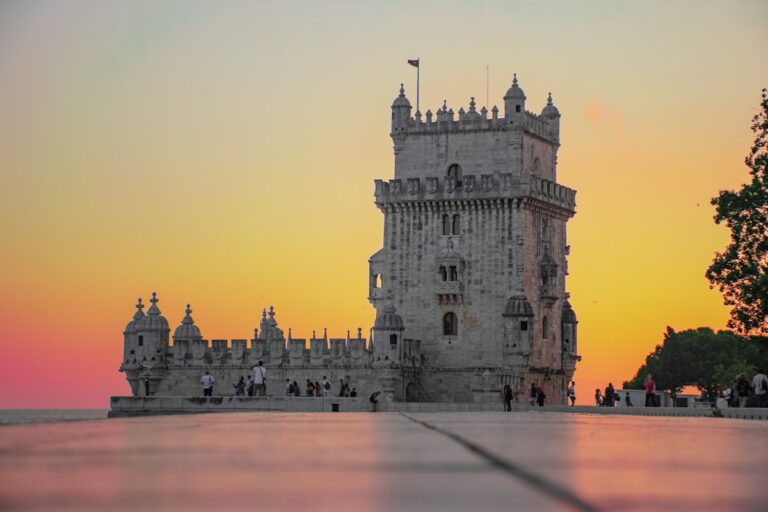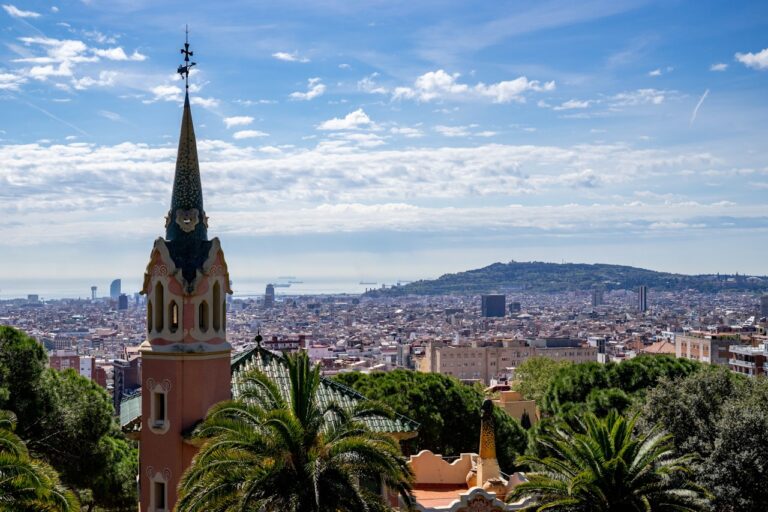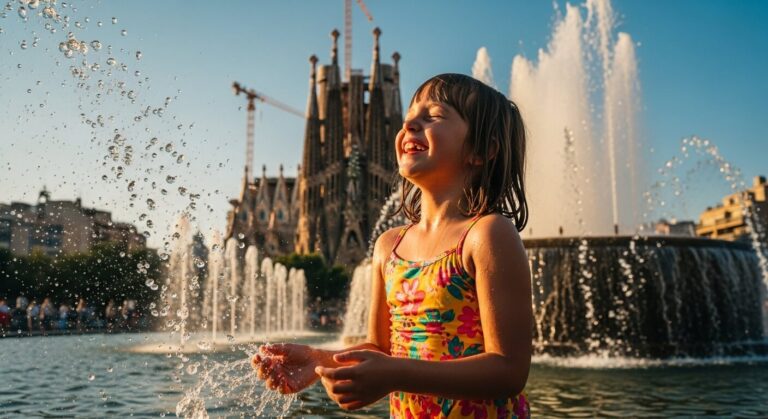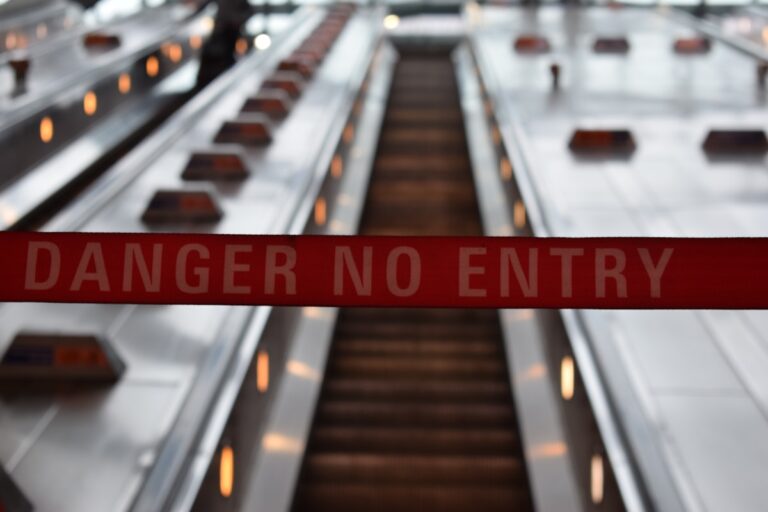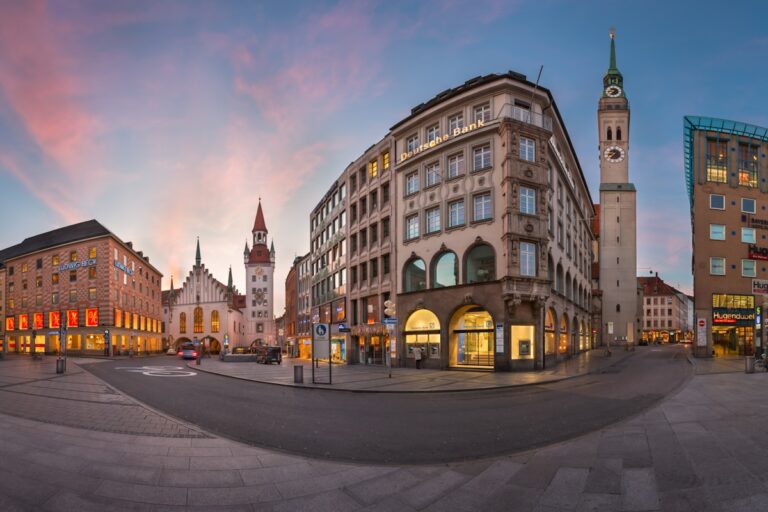17 Best Things to Do in Rome
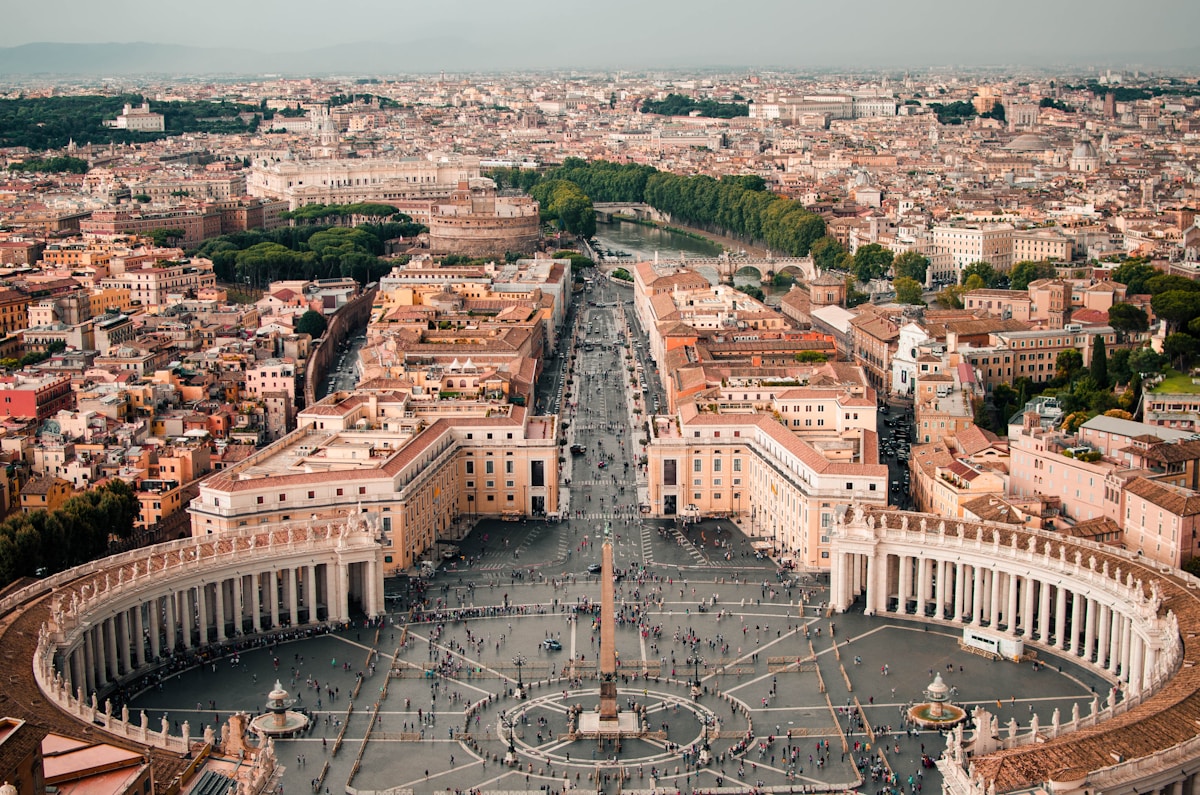
17 Best Things to Do in Rome – Rome is like a living storybook where old and new come together so naturally.
- Exploring Rome's Iconic Landmarks and Historical Sites
- Vatican City: Top Attractions in Rome for Art and Religious Heritage
- Walking Through Rome's Famous Piazzas and Fountains
- Art, Culture, and Hidden Gems in Rome
- Experiencing Local Life and Neighborhood Charm
- Outdoor and Nature Activities in Rome Italy
- Shopping and Souvenir Hunting in Rome
- Evening and Nightlife Activities in Rome
- Planning a Trip to Rome: Tips for Getting the Most Out of Your Visit
- Wrapping Up: Finding the Best Things to Do in Rome
This amazing city offers visitors so many wonderful things to see and do – from incredible buildings that have stood for thousands of years to the vibrant buzz of today’s Italian lifestyle.
Yes, famous places like the Colosseum attract crowds of tourists every year, but the real magic of Rome can be found in its quiet corners, tucked-away squares, and everyday customs that you’ll discover when you wander off the beaten path.
TL;DR
Hide- Visit the Colosseum and Roman Forum complex to explore ancient Rome's most iconic landmarks and archaeological treasures.
- Experience Vatican City's grandeur by touring St. Peter's Basilica, the Sistine Chapel, and extensive Vatican Museums.
- Wander through Trastevere's charming cobblestone streets for authentic Roman dining, local culture, and historic churches.
- Explore the architectural marvel of the Pantheon, featuring the world's largest unreinforced concrete dome and stunning oculus.
- Enjoy evening strolls through illuminated landmarks and experience Rome's vibrant nightlife in Trastevere and Testaccio neighborhoods.
Exploring Rome’s Iconic Landmarks and Historical Sites
The majestic Colosseum stands as Rome’s most recognizable symbol, drawing millions of visitors who walk through the same arches where ancient Romans once gathered for gladiatorial spectacles.
Adjacent to this architectural marvel, the Roman Forum reveals the political and social heart of the ancient empire through its remarkable ruins of government buildings, temples, and public spaces.
The nearby Palatine Hill, traditionally considered Rome’s birthplace, offers panoramic views of these archaeological treasures while showcasing the remains of imperial palaces where Roman emperors once resided.
Colosseum: One of the Best Attractions in Rome
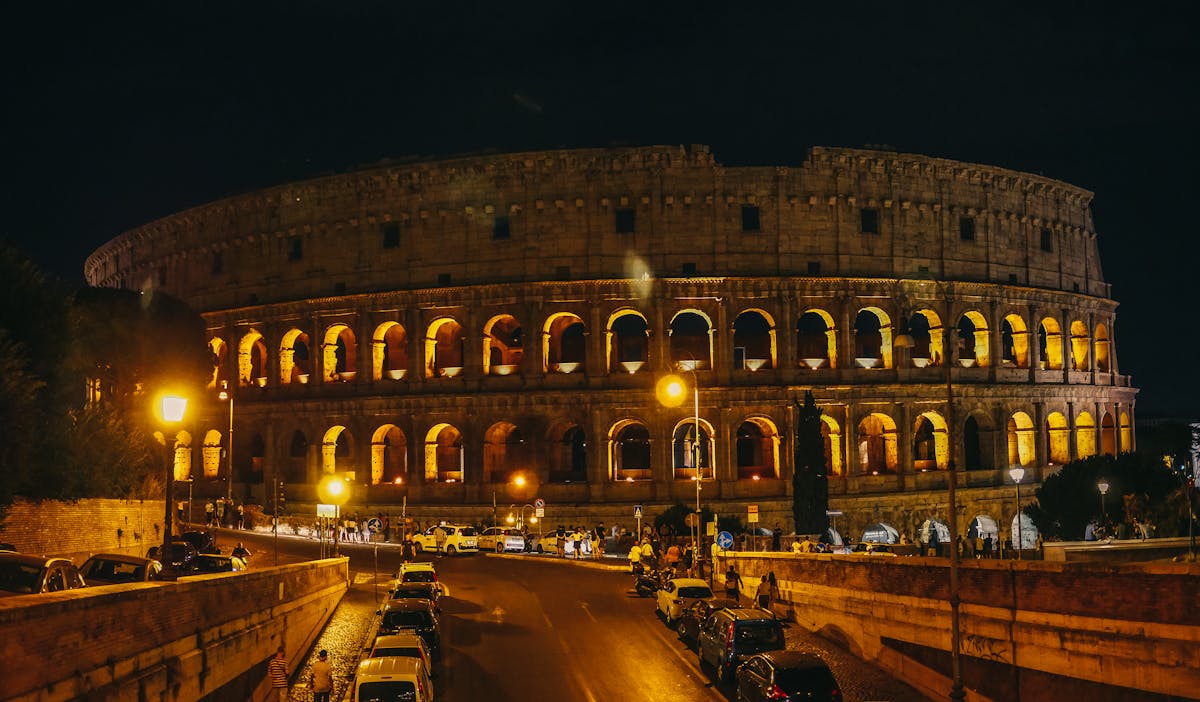
Walking through the towering archways of the Colosseum transports visitors directly into ancient Rome’s most iconic amphitheater, where gladiatorial contests and public spectacles once captivated up to 50,000 spectators.
Colosseum is one of the best places to visit in Rome. The ruins reveal intricate architectural details, including the complex network of underground chambers where gladiators and exotic animals were kept before their appearances in the arena.
Modern tourists can optimize their experience by booking skip-the-line tickets or guided tours in advance, effectively avoiding the notoriously long queues that often stretch around this 2,000-year-old monument.
Walking Through the Ancient Amphitheater’s Historic Ruins
Standing within the massive stone arches of the Colosseum transports visitors back to ancient Rome, where gladiators once fought and spectacles captivated up to 50,000 spectators.
As one of Rome’s top attractions, exploring the amphitheater’s three tiers reveals ancient engineering marvels, while worn stone steps and weathered corridors offer glimpses into the dramatic events that once unfolded in this main Rome attraction.
Booking Tickets and Skip-the-Line Options for a Better Experience
Savvy travelers can greatly reduce their wait times at the Colosseum by booking tickets in advance through the official website or authorized tour operators.
As one of Rome’s top attractions, skip-the-line passes offer priority access to this iconic landmark.
Visitors can combine Colosseum tickets with other tourist attractions in Rome, including the Roman Forum and Palatine Hill, maximizing their exploration of ancient sites.
Roman Forum and Palatine Hill: Must-Do in Rome for History Lovers
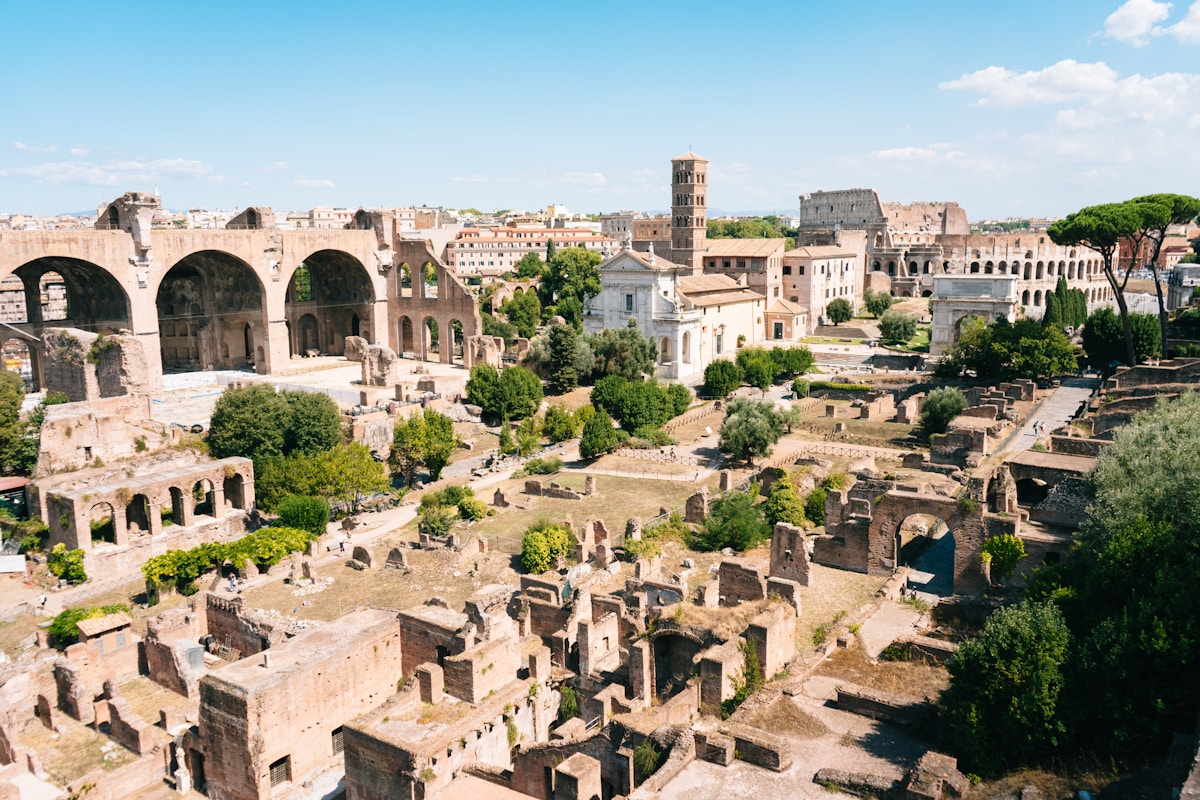
The Roman Forum, once the bustling center of ancient Rome’s political and social activities, contains remarkable ruins of government buildings, temples, and public spaces that shaped the empire’s destiny.
Located adjacent to the Forum, the prestigious Palatine Hill housed the lavish residences of Roman emperors and aristocrats while offering strategic views over the ancient city center.
Today, visitors can walk through these archaeological treasures while admiring panoramic vistas of Rome from the Palatine’s elevated position, gaining insight into how the city’s most powerful citizens lived and governed.
Exploring the Heart of Ancient Rome’s Political and Social Life
Located in the heart of Rome between the Capitoline and Palatine Hills, ancient Rome’s most important gathering place flourished for over a millennium as the epicenter of political, religious, and social life.
Among the top things to see in Rome, visitors can explore the ruins of temples, government buildings, and public spaces where citizens once debated, traded, and celebrated Roman culture.
Scenic Views from Palatine Hill Overlooking the City
Standing atop Rome’s most aristocratic hill, visitors can drink in breathtaking panoramic views that encompass nearly 3,000 years of history.
Among the top things to do in Rome Italy, Palatine Hill offers unparalleled vistas of ancient wonders:
- The sprawling Roman Forum ruins below
- The majestic Circus Maximus chariot racing grounds
- The iconic Colosseum in its full glory
- The seven hills of Rome stretching to the horizon
Vatican City: Top Attractions in Rome for Art and Religious Heritage
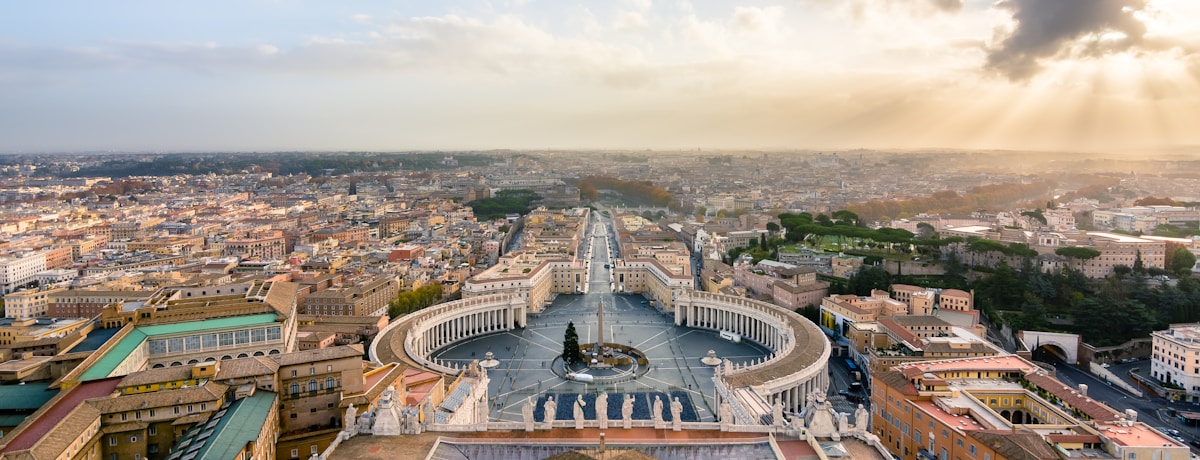
Vatican City stands as a sovereign enclave within Rome, housing two of the most significant attractions for art and religious pilgrimage: St. Peter’s Basilica and the Vatican Museums, one of the best Rome museums.
St. Peter’s Basilica, the world’s largest church and a masterpiece of Renaissance architecture, draws millions of visitors to admire Michelangelo’s Pietà and climb the dome for panoramic views of Rome.
The Vatican Museums showcase an unparalleled collection of classical and Renaissance art, culminating in the Sistine Chapel where Michelangelo’s frescoed ceiling and Last Judgment remain among humanity’s greatest artistic achievements.
St. Peter’s Basilica: One of the Top Things to See in Rome
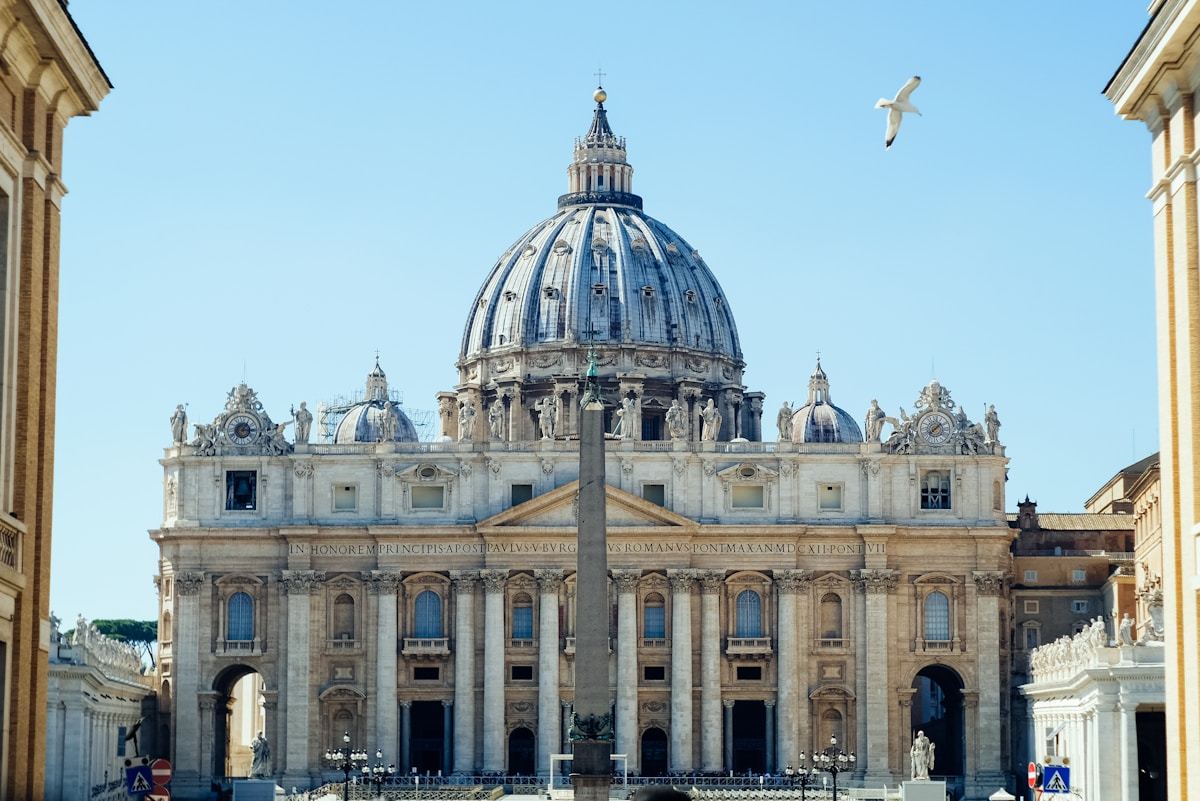
St. Peter’s Basilica offers visitors two extraordinary experiences: ascending the dome for breathtaking panoramic views of Rome and exploring the resplendent interior adorned with masterpieces.
The climb to Michelangelo’s dome, though challenging with its 551 steps, rewards visitors with unparalleled vistas of Vatican City, the Tiber River, and Rome’s historic skyline.
Inside the basilica, Michelangelo’s Pietà stands as a homage to Renaissance genius, while the vast nave, adorned with ornate marble, mosaics, and gilded decorations, exemplifies the grandeur of Catholic architecture.
Climbing to the Dome for Panoramic Views of Rome
At the pinnacle of Catholic Christianity, the climb to Michelangelo’s dome of St. Peter’s Basilica offers one of the best things to do in Rome Italy.
This ascent rewards visitors with breathtaking panoramic views of Vatican City and Rome.
- 551 steps to reach the top
- Option to take elevator halfway
- Interior views of the basilica’s dome mosaics
- 360-degree vistas of Rome’s ancient skyline
Admiring Michelangelo’s Pietà and the Basilica’s Grand Interior
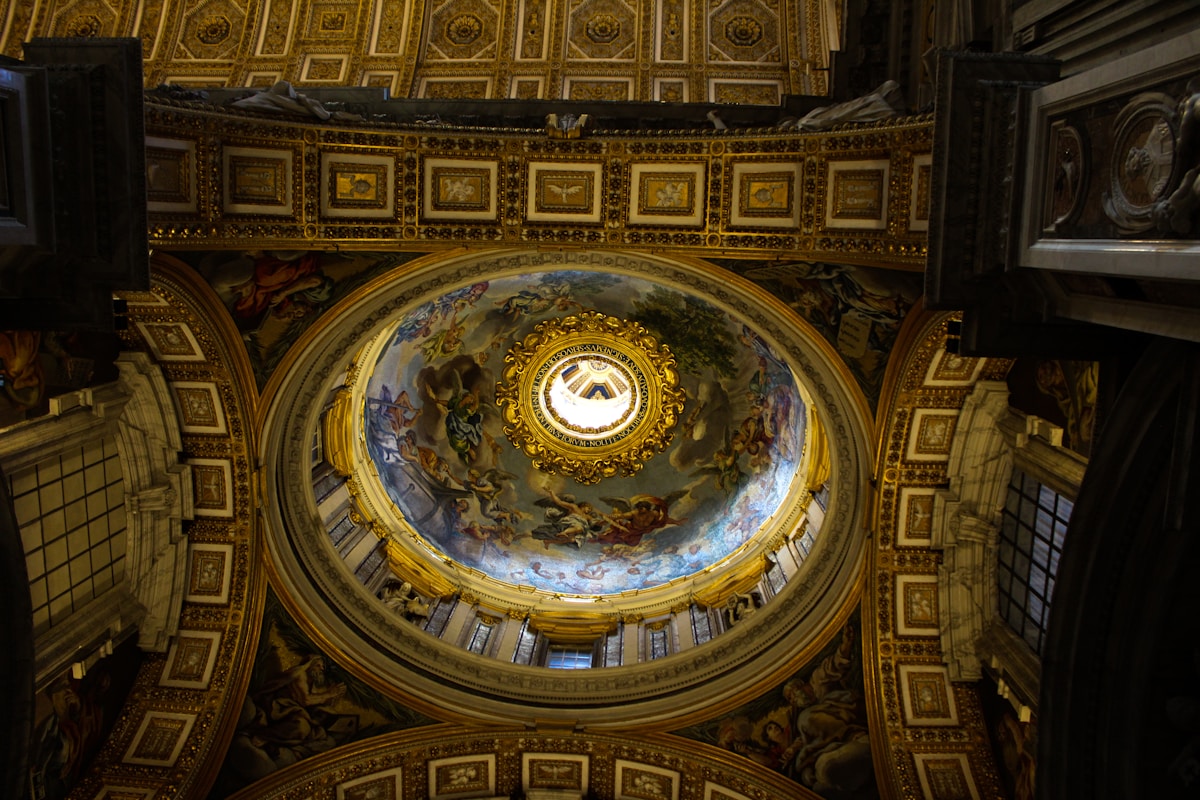
Masterpieces of Renaissance art and architectural grandeur await visitors inside St. Peter’s Basilica, one of the must-do things in Rome.
The crown jewel among fun things to do in Rome is viewing Michelangelo’s Pietà, depicting Mary cradling Jesus.
While exploring what to do in Rome Italy, visitors marvel at the basilica’s ornate marble work, gilded ceiling, and monumental sculptures – essential Rome stuff to do.
Sistine Chapel and Vatican Museums: Must-Do in Rome Italy
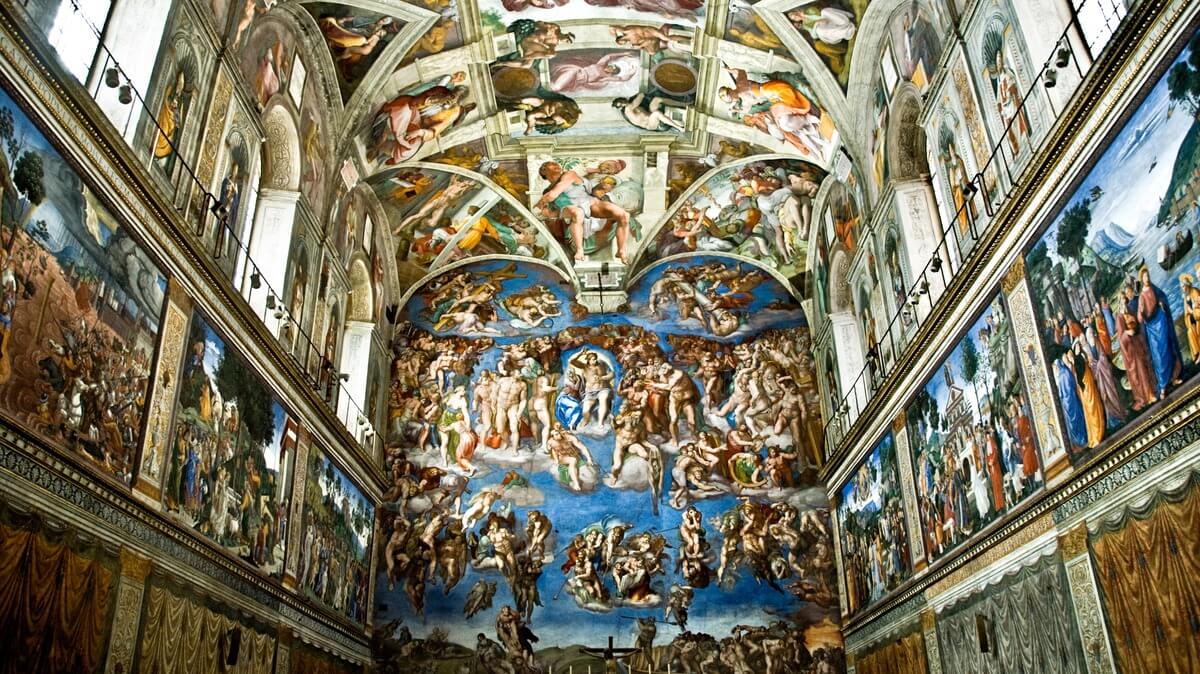
The Sistine Chapel stands as the crown jewel of the Vatican Museums, where Michelangelo’s masterful frescoes, particularly “The Creation of Adam” on the ceiling and “The Last Judgment” on the altar wall, have captivated visitors for centuries.
The Vatican Museums house one of the world’s most extensive collections of classical sculptures, Renaissance art, and historical artifacts across 54 galleries spanning four millennia.
Visitors can trace humanity’s artistic and cultural evolution while admiring works by masters like Raphael, Leonardo da Vinci, and Caravaggio in these hallowed halls.
Seeing Michelangelo’s Iconic Frescoes Up Close
Standing beneath Michelangelo’s majestic frescoes in the Sistine Chapel remains one of humanity’s most profound artistic encounters.
The masterpiece, completed between 1508 and 1512, showcases extraordinary Biblical narratives across the chapel’s ceiling.
- The Creation of Adam centerpiece depicts divine touch
- Nine scenes from Genesis unfold chronologically
- More than 300 figures populate the lively frescoes
- The Last Judgment on the altar wall took four years to complete
Touring the Vast Collection of Art and Artifacts
Beyond the Sistine Chapel’s celestial frescoes, visitors encounter one of Earth’s most extensive art collections within the Vatican Museums‘ sprawling corridors.
Ancient Roman sculptures, Renaissance masterpieces, and Egyptian antiquities line the galleries. The Raphael Rooms showcase lively frescoes, while the Gallery of Maps features 16th-century topographical maps.
The Pinacoteca houses paintings by Caravaggio, Leonardo da Vinci, and other masters.
Walking Through Rome’s Famous Piazzas and Fountains
Rome’s iconic piazzas and fountains showcase the city’s remarkable Baroque architecture and lively social culture, with the magnificent Trevi Fountain standing as the most famous water feature in the world.
The bustling Piazza Navona pulses with street artists, cafes, and ornate fountains surrounding Bernini’s masterpiece Fountain of the Four Rivers.
The Spanish Steps rise majestically from Piazza di Spagna, offering visitors a grand baroque staircase that leads to panoramic views of the Eternal City’s domes and bell towers.
Trevi Fountain: One of the Best Things to See in Rome
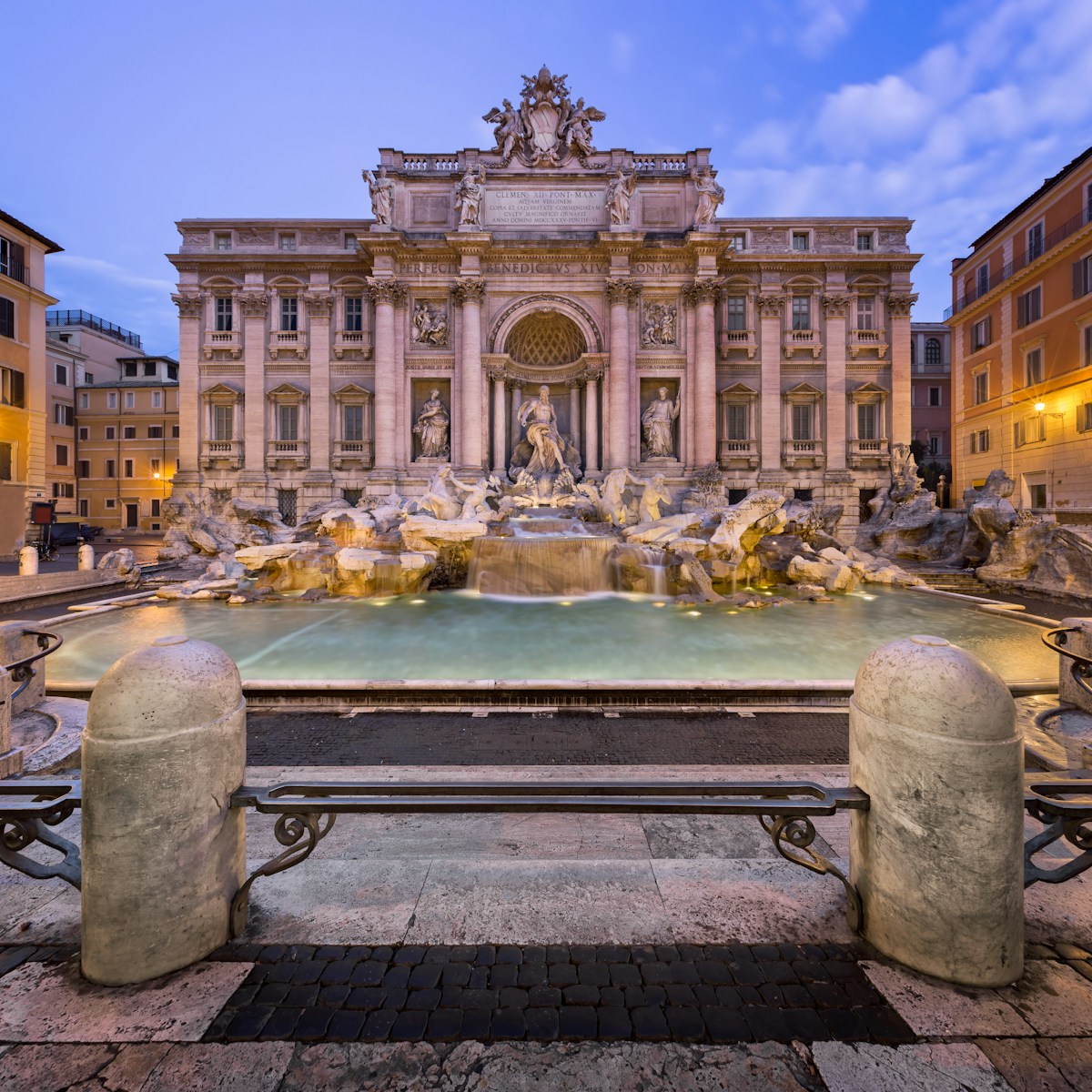
The Trevi Fountain attracts visitors enthusiastic to participate in the time-honored tradition of tossing a coin over their left shoulder with their right hand, which legend promises will guarantee a return trip to Rome.
For the best experience at this iconic Baroque masterpiece, travelers should arrive before 7 AM or after 11 PM to avoid the typically dense crowds and capture unobstructed photos of the intricate sculptures and cascading waters.
The fountain’s illumination after sunset creates a particularly enchanting atmosphere, though early morning offers the clearest light for photography and a rare moment of tranquility at this popular landmark.
Tossing a Coin for Good Luck and Future Visits
Tossing coins into Trevi Fountain ranks among Rome’s most beloved traditions, dating back to the 1954 film “Three Coins in the Fountain.”
According to legend, throwing one coin over your left shoulder guarantees a return visit to Rome, while two coins might lead to romance with an Italian, and three could result in marriage.
- An estimated €3,000 is thrown into the fountain daily
- Coins are collected nightly and donated to charity
- The proper technique requires using your right hand over your left shoulder
- Standing with your back to the fountain assures the most authentic experience
Best Times to Visit for Fewer Crowds and Great Photos
While Trevi Fountain draws massive crowds throughout the day, visiting during off-peak hours offers the best opportunities for unobstructed views and memorable photographs.
Early morning visits between 6-7 AM provide serene moments before tourist buses arrive.
Alternatively, midnight to 2 AM presents a magical atmosphere when the fountain’s illumination creates dramatic lighting effects against the Baroque architecture.
Piazza Navona: A Fun Thing to Do in Rome for a Lively Atmosphere
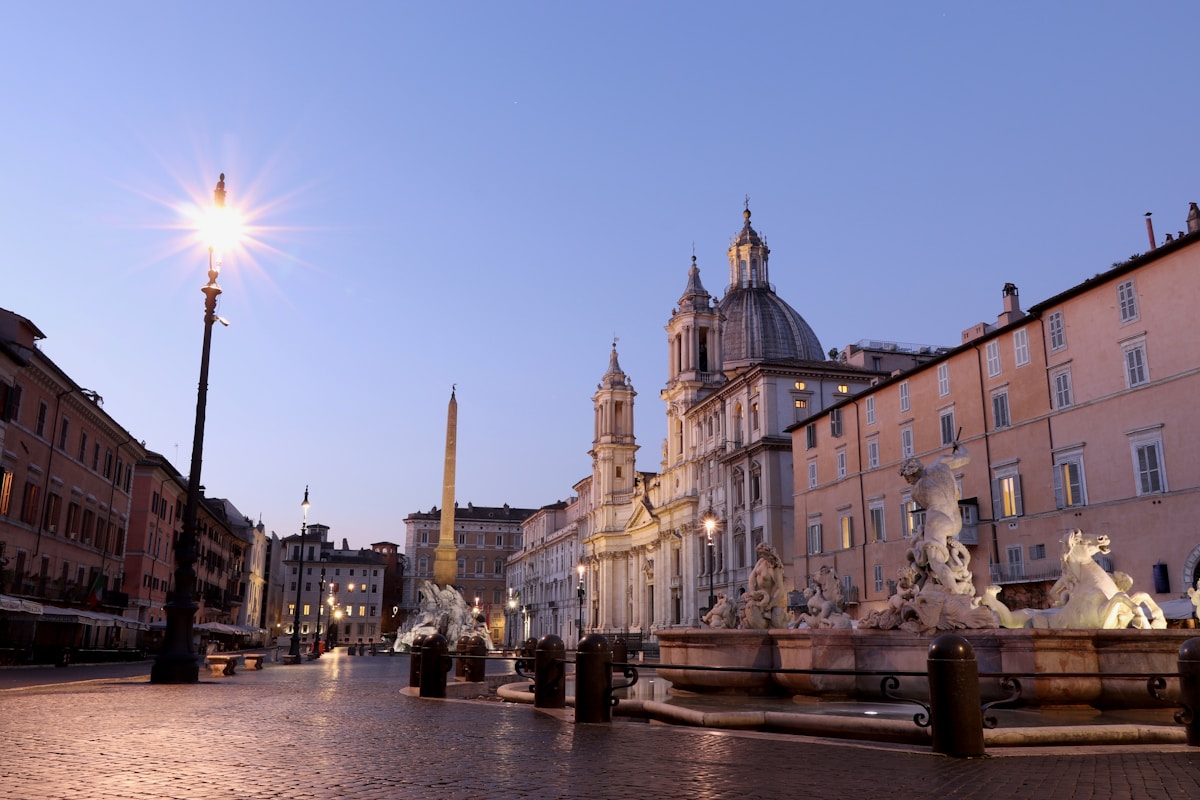
Piazza Navona captivates visitors with its three magnificent Baroque fountains, including Bernini’s masterpiece Fountain of the Four Rivers at its center.
The square’s lively atmosphere comes alive with street artists, musicians, and portrait painters performing against the backdrop of colorful buildings and outdoor cafés.
Local vendors and artisans display their wares in market stalls around the piazza, while visitors and Romans alike gather at the surrounding restaurants to savor authentic Italian cuisine and watch the lively scene unfold.
Enjoying Bernini’s Fountains and the Local Street Performers
Located in the heart of Rome’s historic center, Piazza Navona stands as one of the city’s most beloved gathering spots, where Bernini’s magnificent fountains merge with the lively energy of street performers and local artists.
- Fontana dei Quattro Fiumi, Bernini’s masterpiece, depicts four river gods representing major continents.
- Street musicians fill the air with traditional Italian melodies.
- Local artists capture the piazza’s beauty through paintings and sketches.
- Mime artists and acrobats entertain crowds between the baroque fountains.
Cafés, Restaurants, and Market Stalls Around the Square
Surrounding Bernini’s magnificent fountains, an enticing array of cafés, trattorias, and market stalls line the elegant perimeter of this historic square.
Visitors can savor authentic Roman cuisine at traditional establishments, sip espresso at outdoor tables, or browse local artisans’ works.
As evening approaches, the restaurants come alive with the sounds of clinking glasses and animated conversations, offering a quintessential Roman dining experience.
Spanish Steps: A Top Attraction in Rome for City Views
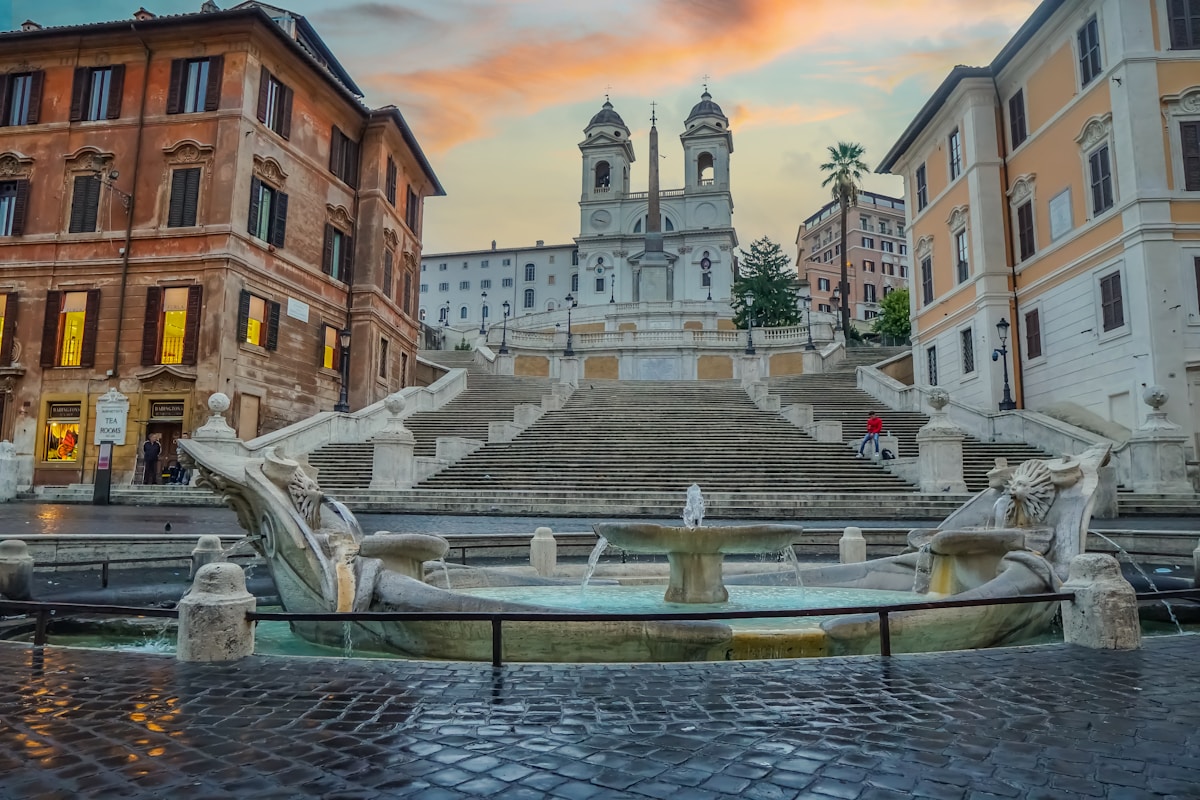
The Spanish Steps‘ grand 174-step staircase rises dramatically from Piazza di Spagna to Trinità dei Monti church, offering one of Rome’s most photogenic vantage points over the historic center.
At the summit, visitors are rewarded with sweeping views of the elegant piazza below, complete with Bernini’s iconic Fontana della Barcaccia fountain.
The surrounding area has evolved into one of Rome’s most fashionable districts, where luxury shopping along Via Condotti meets charming cafés perfect for people-watching.
Climbing to the Top for a Scenic Overlook of Piazza di Spagna
Standing majestically between Piazza di Spagna and Piazza Trinità dei Monti, Rome’s iconic Spanish Steps invite visitors to ascend its 135 baroque-style marble stairs for breathtaking views over the Eternal City.
From the summit, visitors discover:
- Sweeping vistas of Rome’s terracotta rooftops and church domes
- The elegant Piazza di Spagna with its Fontana della Barcaccia below
- The twin bell towers of Trinità dei Monti church
- A perfect vantage point for capturing Rome’s golden hour
Exploring the Designer Boutiques and Cafés Nearby
Nestled along the elegant streets radiating from Piazza di Spagna, luxury fashion houses and historic cafés create one of Rome’s most prestigious shopping districts.
Via Condotti showcases renowned Italian brands like Prada, Gucci, and Bulgari, while Via del Babuino and Via Margutta offer artisanal boutiques and antique shops.
Visitors can pause at Caffè Greco, Rome’s oldest café, where literary legends once gathered.
Art, Culture, and Hidden Gems in Rome
The magnificent Pantheon stands as Rome’s best-preserved ancient monument, featuring the world’s largest unreinforced concrete dome and an oculus that bathes the interior in natural light.
A short walk along the Tiber River leads to Castel Sant’Angelo, a fortress-turned-museum originally built as Emperor Hadrian’s mausoleum in 139 AD.
These architectural marvels offer visitors a chance to experience both the grandeur of Roman engineering and centuries of historical transformations, from ancient temple to Christian church in the Pantheon’s case, and from imperial tomb to papal fortress in Castel Sant’Angelo’s evolution.
Pantheon: One of the Top Ten Things to Do in Rome
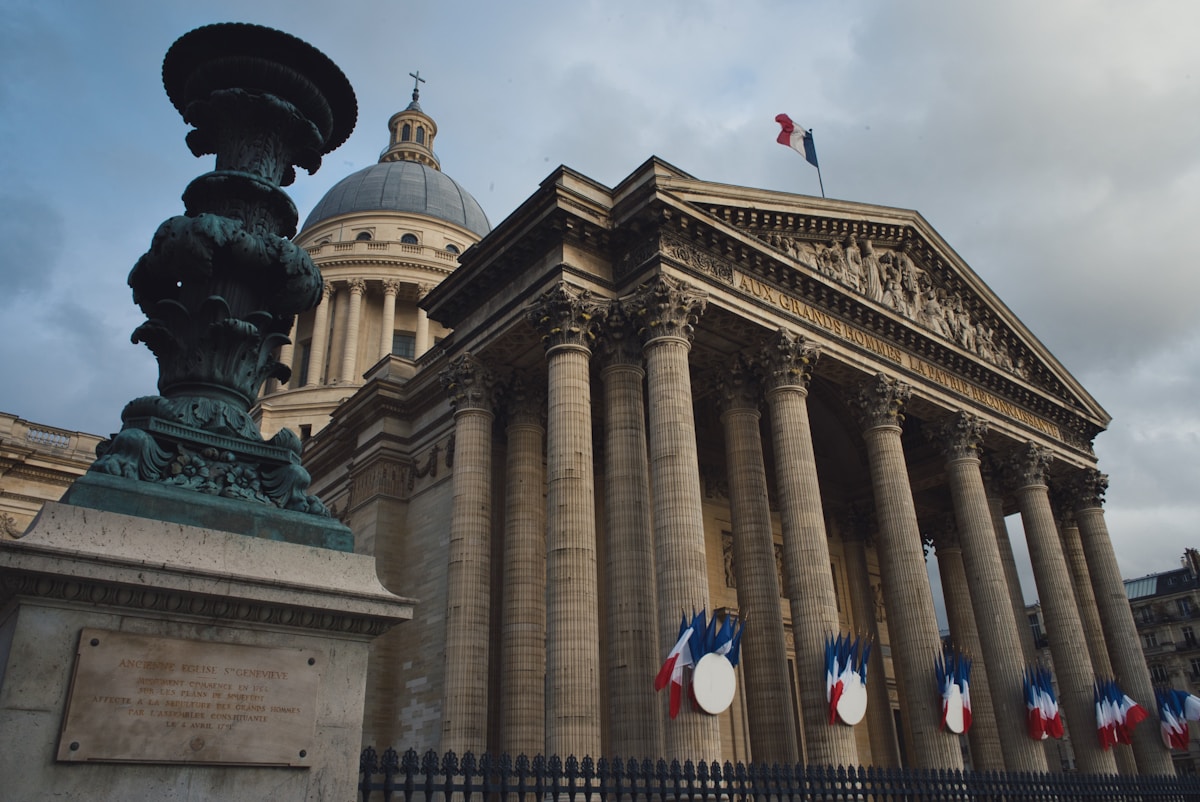
The Pantheon stands as a masterpiece of Roman engineering, showcasing architectural innovation through its massive concrete dome and central oculus.
The 27-foot-wide circular opening in the dome acts as the building’s sole light source, creating a dramatic interplay between light and shadow as sunbeams traverse the interior throughout the day.
This celestial connection transforms the temple’s atmosphere as the oculus projects a moving spotlight across the ornate marble floors and walls, offering visitors a different perspective with each passing hour.
The Architectural Genius of the Ancient Roman Temple
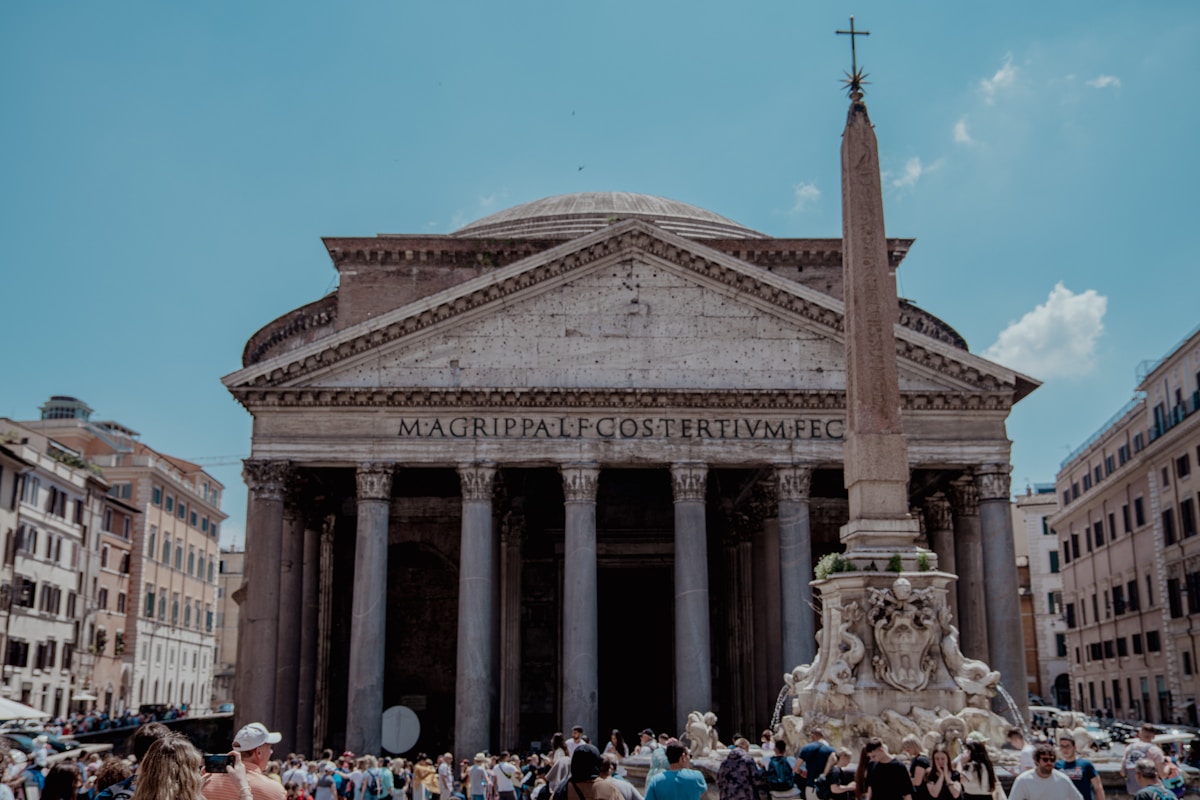
Standing as Rome’s crowning architectural achievement, the Pantheon exemplifies the ingenious engineering and artistic vision of ancient Roman builders.
The temple’s perfect proportions and revolutionary dome construction continue to influence architecture worldwide.
- Massive 142-foot concrete dome remains the world’s largest unreinforced concrete dome
- Oculus, a 27-foot circular opening, dramatically illuminates the interior
- Precise mathematical ratios create perfect spherical harmony
- Revolutionary weight-reduction techniques include coffered ceiling and lightweight aggregates
How the Oculus Creates a Unique Light Display Inside
Streaming through the oculus, sunlight performs an ever-changing dance across the Pantheon’s interior, creating a mesmerizing display that ancient Romans believed connected them to their gods.
As the Earth rotates, this 27-foot-wide opening channels a concentrated beam of light that circles the dome’s coffered ceiling and illuminates different sections of the marble floor, marking time like a celestial sundial.
Castel Sant’Angelo: Rome Attractions with a Fortress-Like Appeal
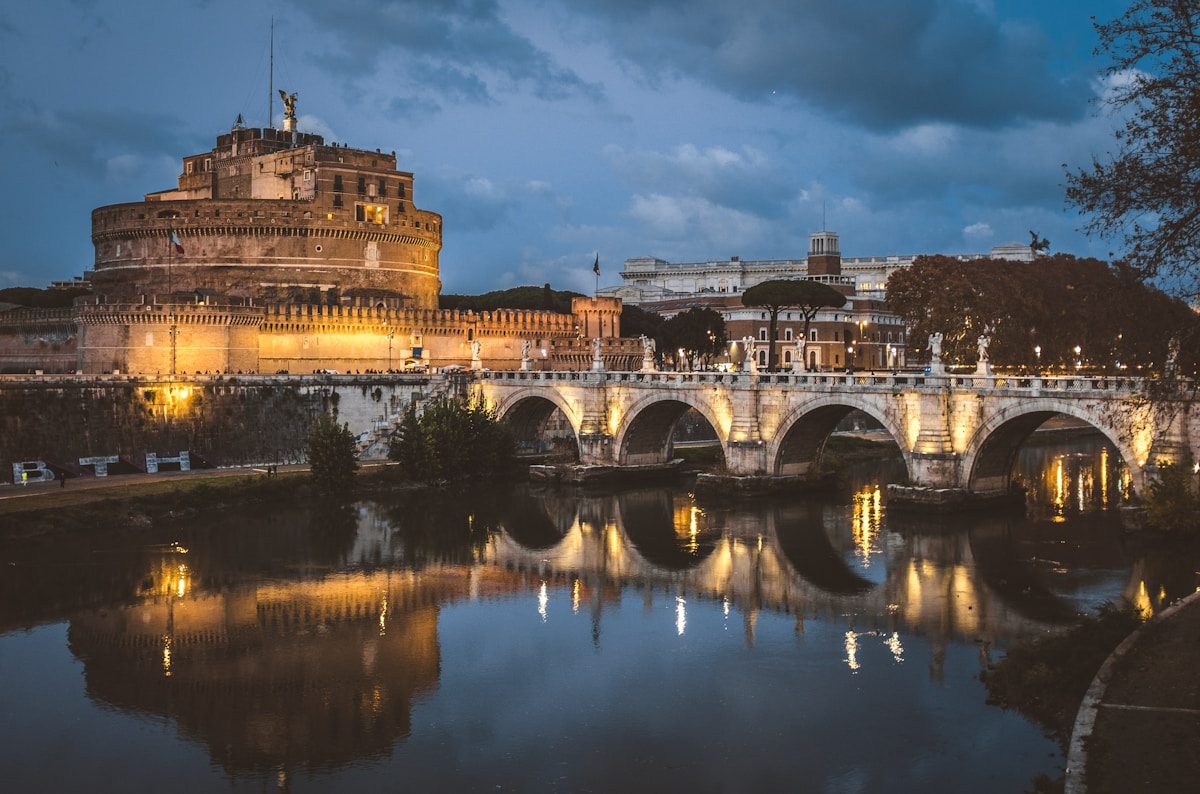
Castel Sant’Angelo’s imposing fortress structure houses a labyrinth of historic rooms and secret passageways that once served as both a papal refuge and military stronghold.
Visitors can explore the castle’s winding corridors, which showcase Renaissance frescoes, papal apartments, and military artifacts spanning nearly two millennia of Roman history.
The castle’s circular terrace offers breathtaking panoramic views of the Tiber River and Vatican City, with Saint Peter’s Basilica dominating the skyline.
Walking Through the Castle’s Historic Rooms and Passageways
As visitors traverse the historic corridors of Castel Sant’Angelo, they encounter a fascinating blend of papal chambers, military quarters, and Renaissance artistry that chronicles Rome’s complex history.
- Splendid papal apartments showcase ornate frescoes and period furnishings.
- Secret Passetto di Borgo once provided escape routes for endangered popes.
- Former prison cells reveal darker chapters of Rome’s past.
- Spiral ramps built during Emperor Hadrian’s time remain intact.
Rooftop Views of the Tiber River and Vatican City
The crown jewel of Castel Sant’Angelo awaits visitors who climb to its uppermost level – a panoramic terrace offering breathtaking views of Rome’s historic landscape.
From this elevated vantage point, visitors can trace the serpentine path of the Tiber River, marvel at St. Peter’s Basilica’s imposing dome, and survey the Vatican City’s manicured gardens against the backdrop of Rome’s timeless skyline.
Experiencing Local Life and Neighborhood Charm
Rome’s lively local neighborhoods offer authentic cultural experiences away from the tourist crowds, with Trastevere and Testaccio standing out as must-visit destinations.
Trastevere’s cobblestone streets and ivy-covered buildings house family-run trattorias, artisan shops, and bustling piazzas where locals gather for their evening passeggiata.
Testaccio, Rome’s historic working-class district, has transformed into a culinary hotspot, featuring the city’s premier food market and restaurants serving traditional Roman dishes like trippa alla romana and cacio e pepe.
Trastevere: A Fun Thing to Do in Rome for Food and Culture
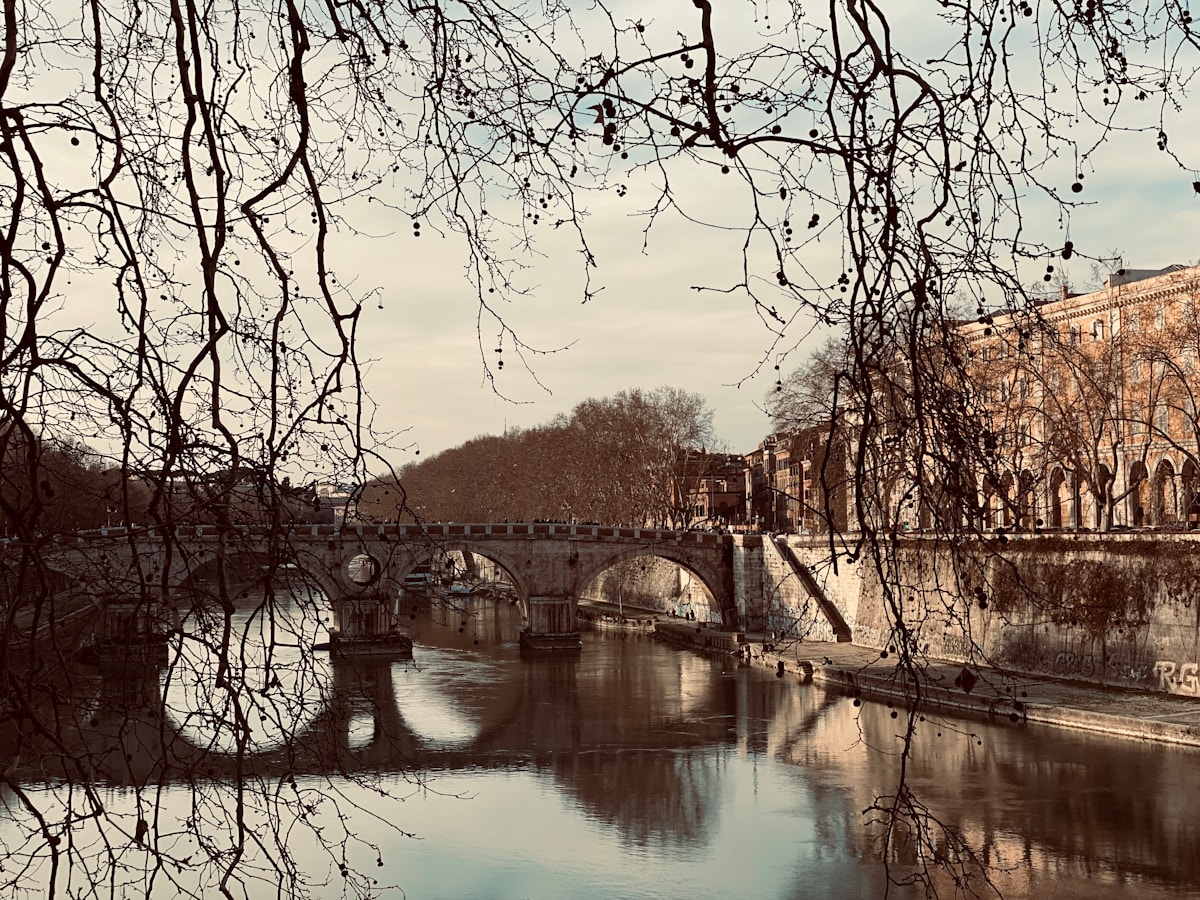
Wandering through Trastevere’s maze of cobblestone alleyways offers visitors an authentic glimpse into Roman neighborhood life, where ivy-draped buildings and local trattorias create an atmosphere distinctly different from the city’s tourist centers.
At the heart of this medieval quarter stands the Santa Maria in Trastevere, one of Rome’s oldest churches, featuring spectacular 12th and 13th-century mosaics that shimmer with golden light.
The neighborhood’s winding lanes reveal hidden piazzas where locals gather at cafes, while artisan shops and centuries-old buildings showcase the area’s preserved historical character.
Strolling Through Narrow Streets Filled with Local Charm
Among Rome’s most beloved neighborhoods, Trastevere captivates visitors with its medieval cobblestone lanes, ivy-draped buildings, and authentic Roman atmosphere.
Wandering these intimate passages reveals the genuine spirit of Roman life, where locals and travelers alike discover:
- Hidden artisan workshops and boutiques
- Centuries-old churches with stunning mosaics
- Charming piazzas where residents gather
- Traditional family-run trattorias serving Roman classics
Visiting Santa Maria in Trastevere for Stunning Mosaics

The magnificent Santa Maria in Trastevere, one of Rome’s oldest churches, stands as the crown jewel of this charming neighborhood.
Dating back to the 4th century, its glittering medieval mosaics depict biblical scenes in stunning detail.
Visitors can marvel at the gilded octagonal ceiling, ancient marble columns, and the mesmerizing 12th-century apse mosaic of Christ and Mary sharing a throne.
Testaccio: Rome Tourist Attractions for Food Lovers
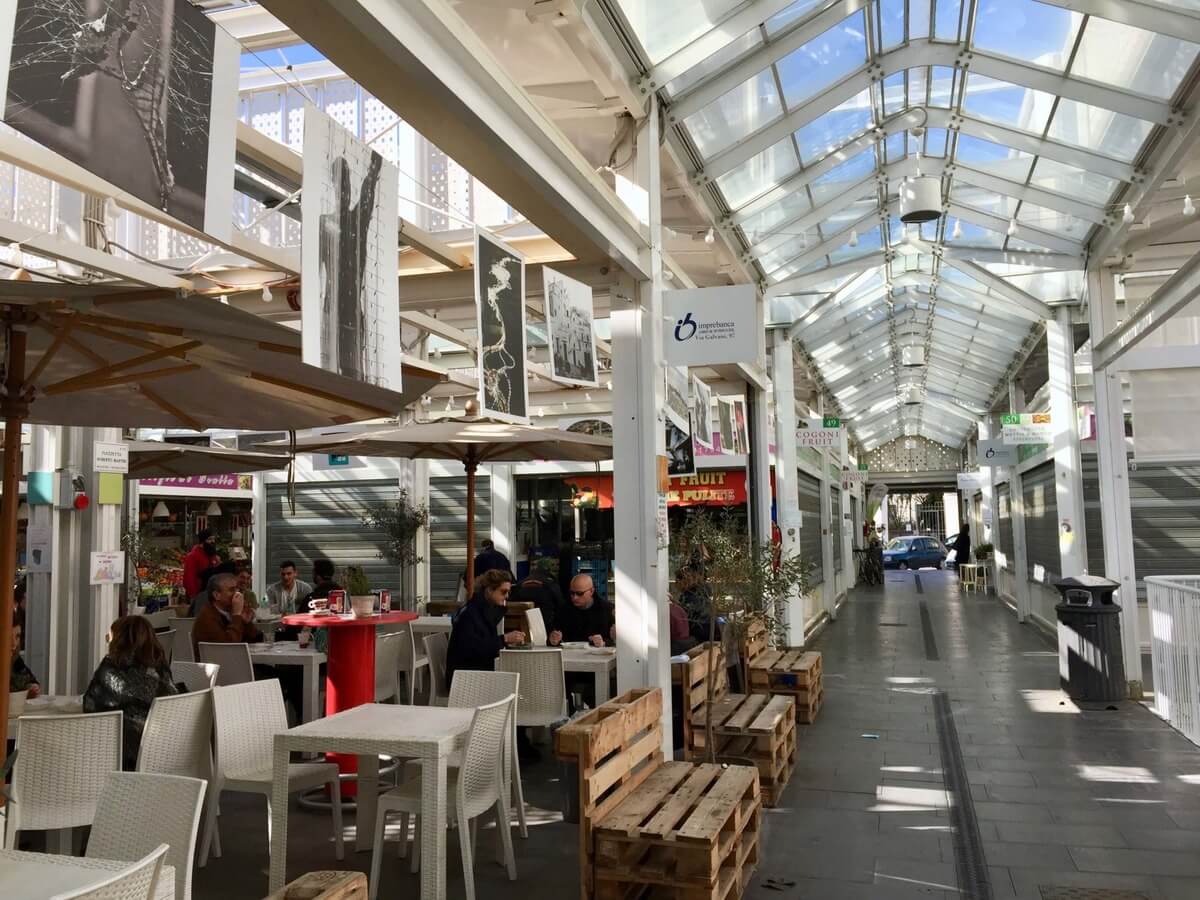
Testaccio, Rome’s historic working-class district and culinary heart, offers visitors an authentic taste of traditional Roman cuisine away from the city’s more tourist-heavy areas.
The neighborhood’s centerpiece, Testaccio Market, showcases an array of fresh produce, local specialties, and affordable street food vendors where locals gather for their daily shopping and casual meals.
Beyond the market, the district’s trattorias and osterias serve classic Roman dishes like trippa alla romana, coda alla vaccinara, and pasta all’amatriciana, preserving recipes that reflect the area’s deep-rooted connection to Rome’s culinary heritage.
Sampling Traditional Roman Dishes in a Less Touristy District
Located away from Rome’s tourist-heavy center, Testaccio district offers visitors an authentic slice of Roman culinary life where locals still shop, eat, and socialize.
Traditional flavors shine through the district’s historic eateries, where adventurous diners discover:
- Cacio e Pepe served in family-run trattorias
- Authentic Roman offal dishes at century-old restaurants
- Fresh produce at Testaccio Market
- House-made pasta at neighborhood osterie
Exploring the Testaccio Market for Fresh and Affordable Eats
Among Rome’s most lively culinary destinations, Mercato di Testaccio stands as a bustling food market where local vendors have been selling fresh produce, artisanal products, and ready-to-eat specialties since 1914.
Visitors can explore over 100 stalls offering seasonal ingredients, homemade pasta, regional cheeses, and traditional street food at reasonable prices, while mingling with Romans going about their daily shopping routines.
Outdoor and Nature Activities in Rome Italy
Rome’s green spaces offer tranquil alternatives to the bustling city streets, with the Villa Borghese Gardens standing as a magnificent 148-acre park featuring manicured Italian gardens, museums, and a serene lake for rowboat rentals.
The ancient Appian Way, known as the “Queen of Roads,” stretches beyond the city walls, where visitors can cycle or walk along the historic cobblestones past Roman ruins and early Christian catacombs.
These outdoor havens provide both historical significance and natural beauty, allowing travelers to experience Rome’s heritage while enjoying fresh air and open spaces.
Villa Borghese Gardens: A Peaceful Escape from the City
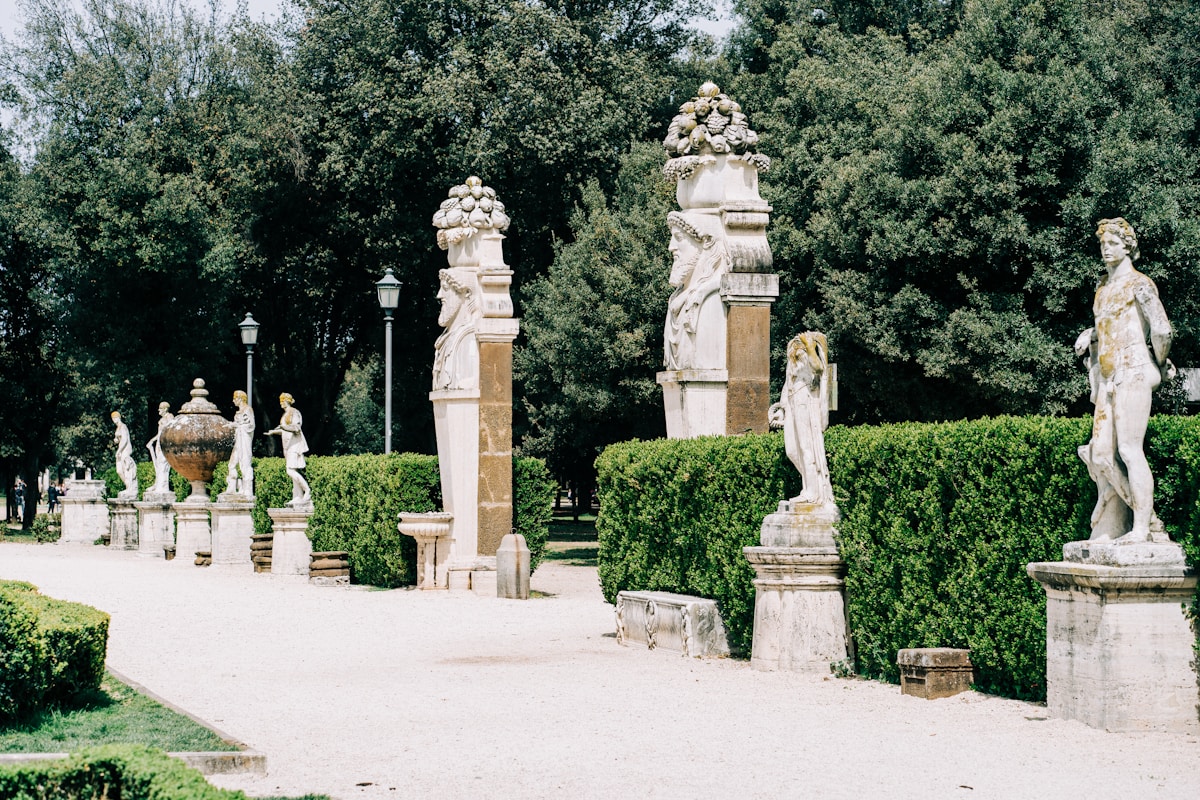
The Villa Borghese Gardens offer visitors a lush 198-acre oasis in central Rome where renting a bicycle or taking a tranquil stroll provides welcome relief from the city’s bustling streets.
Within these manicured grounds, tree-lined paths wind past fountains, lake views, and hidden sculptures that reveal the park’s noble origins as a 17th-century cardinal’s private estate.
At the heart of the gardens stands the renowned Galleria Borghese, housing masterpieces by Bernini, Caravaggio, and Raphael in an opulent villa setting that requires advance reservations to visit its world-class collection.
Renting a Bike or Taking a Leisurely Walk Through the Park
Escaping Rome’s bustling streets, visitors find tranquil refuge in Villa Borghese Gardens, where renting a bike or taking a peaceful stroll offers an ideal way to explore this sprawling 198-acre park.
- Bike rentals available near Pincian Hill entrance, with hourly and daily rates
- Tree-lined paths wind past scenic lakes, temples, and hidden sculptures
- Multiple walking routes accommodate different fitness levels and interests
- Several scenic viewpoints provide perfect photo opportunities of Rome’s skyline
Read our recommendations of the best parks in Rome.
Visiting Galleria Borghese for Stunning Art Collections
Nestled within Villa Borghese Gardens, Galleria Borghese stands as one of Italy‘s most prestigious art museums, housing an exceptional collection of Renaissance and Baroque masterpieces.
Visitors marvel at Bernini’s sculptural works, Caravaggio’s paintings, and Titian’s masterpieces within the 20-room gallery.
Advanced reservations are required for the two-hour visiting slots, allowing art enthusiasts to experience the collection without crowds.
Appian Way: A Fun Thing to Do in Rome for Outdoor Enthusiasts

The ancient Appian Way, considered Rome’s most important road during the Roman Republic, offers visitors a chance to walk or cycle along the same stone paths where Roman legions once marched.
History enthusiasts can explore the historic Christian catacombs of San Sebastiano and San Callisto, which feature miles of underground tunnels containing ancient tombs and early Christian art.
The well-preserved stretch of the road, lined with umbrella pines and Roman ruins, provides a unique outdoor experience that combines archaeological significance with natural beauty.
Walking or Cycling on One of the Oldest Roads in Rome
Among Rome’s most remarkable ancient thoroughfares, Via Appia Antica (Appian Way) offers visitors a chance to step back in time while enjoying outdoor recreation in the heart of Italian countryside.
- Stretches 33 miles from Rome to Brindisi, paved with original Roman stones
- Bike rentals available at multiple points along the historic route
- Ancient Roman tombs and catacombs line the path
- Peaceful escape from city crowds while exploring ruins and countryside
Visiting the Catacombs of San Sebastiano and San Callisto
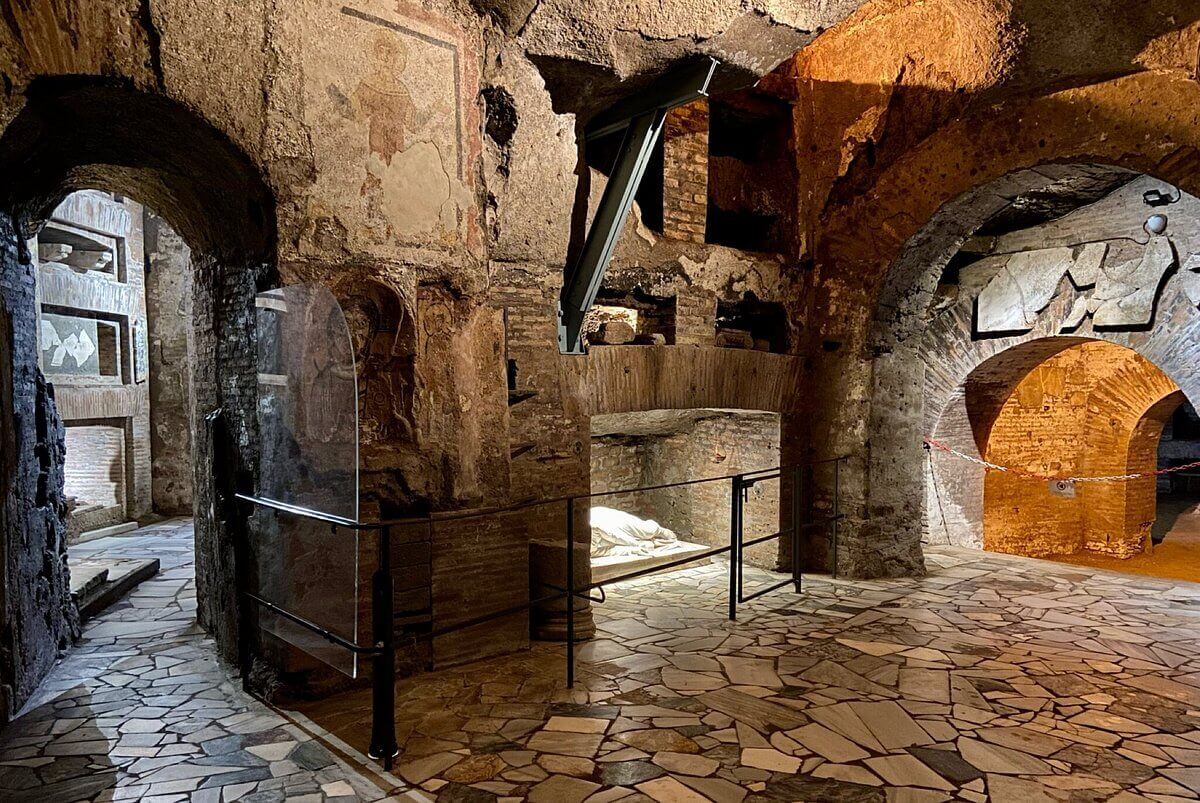
Located beneath the ancient Appian Way, Rome’s most extensive network of catacombs offers visitors a fascinating glimpse into early Christian burial practices and religious art.
The catacombs of San Sebastiano and San Callisto feature miles of underground tunnels adorned with frescoes, inscriptions, and burial niches.
These sacred spaces, dating back to the 2nd century, serve as both archaeological treasures and powerful symbols of early Christian persecution.
Shopping and Souvenir Hunting in Rome
Rome’s historic shopping districts offer distinct retail experiences that showcase the city’s lively commercial culture.
Campo de’ Fiori, a bustling open-air market dating back to medieval times, draws visitors with its colorful displays of fresh produce, flowers, and artisanal goods set against Renaissance architecture.
The Via del Corso, stretching from Piazza Venezia to Piazza del Popolo, presents a mile-long corridor of fashion boutiques, international brands, and Italian designers in elegant nineteenth-century buildings.
Campo de’ Fiori: One of the Best Attractions in Rome for Market Lovers
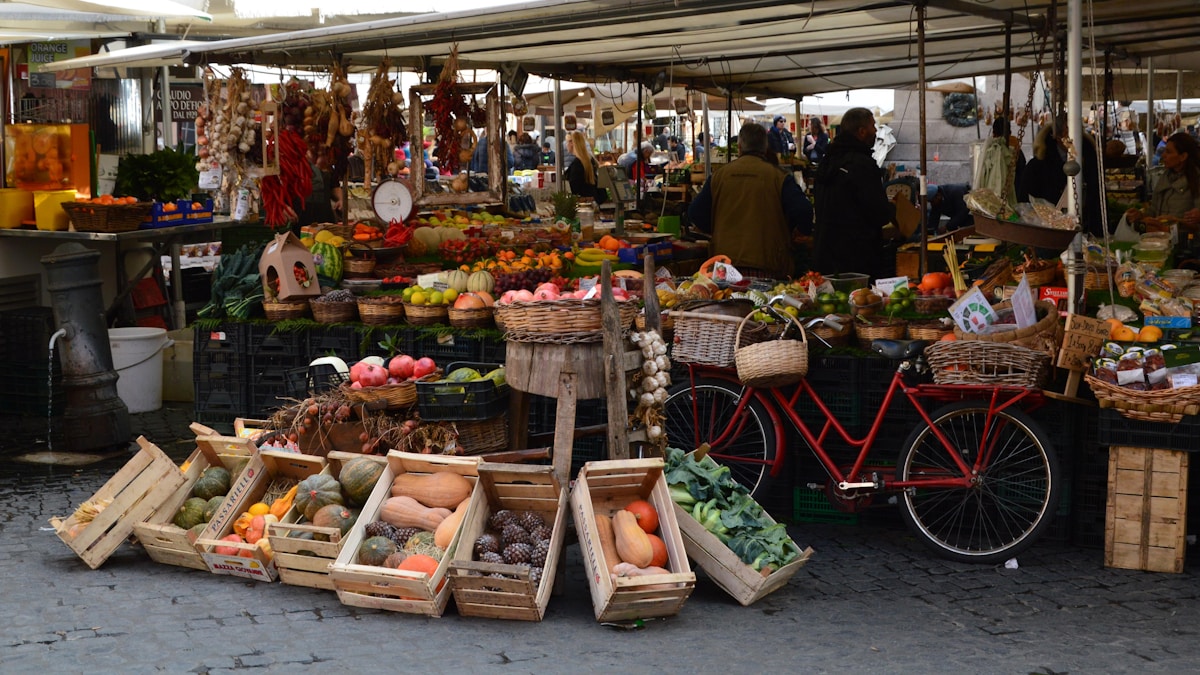
Campo de’ Fiori, Rome’s oldest marketplace, transforms each morning into a lively open-air market where locals and tourists gather to browse stalls overflowing with fresh produce, flowers, spices, and artisanal goods.
The historic square, whose name translates to “Field of Flowers,” is surrounded by charming cafés and traditional Roman restaurants that offer perfect vantage points for people-watching while sampling authentic Italian cuisine.
Beyond the daytime market hours, the piazza maintains its animated atmosphere as visitors explore the specialty shops in neighboring streets and embrace the square’s reputation as a cultural hub where Roman daily life unfolds.
Exploring the Daily Open-Air Market for Local Goods and Fresh Produce
Where medieval merchants once gathered to trade their wares, the Campo de’ Fiori now stands as Rome’s most lively open-air market.
Locals and tourists mingle amid colorful stalls from dawn until dusk, discovering authentic Italian treasures.
- Fresh seasonal produce from local farmers
- Handcrafted pastas and regional specialties
- Artisanal olive oils and aged balsamic vinegars
- Traditional spices and aromatic dried flowers
Enjoying Cafés and Restaurants Lining the Historic Square
Dozens of charming cafés and trattorias encircle Campo de’ Fiori‘s perimeter, offering visitors a perfect vantage point to observe the square’s bustling atmosphere while savoring authentic Roman cuisine.
Local establishments serve classic dishes like pasta alla carbonara and Roman-style pizza, complemented by regional wines.
These historic eateries, some dating back generations, provide an authentic taste of Roman culinary traditions beyond typical tourist fare.
Via del Corso: A Top Attraction in Rome for Shopping Enthusiasts
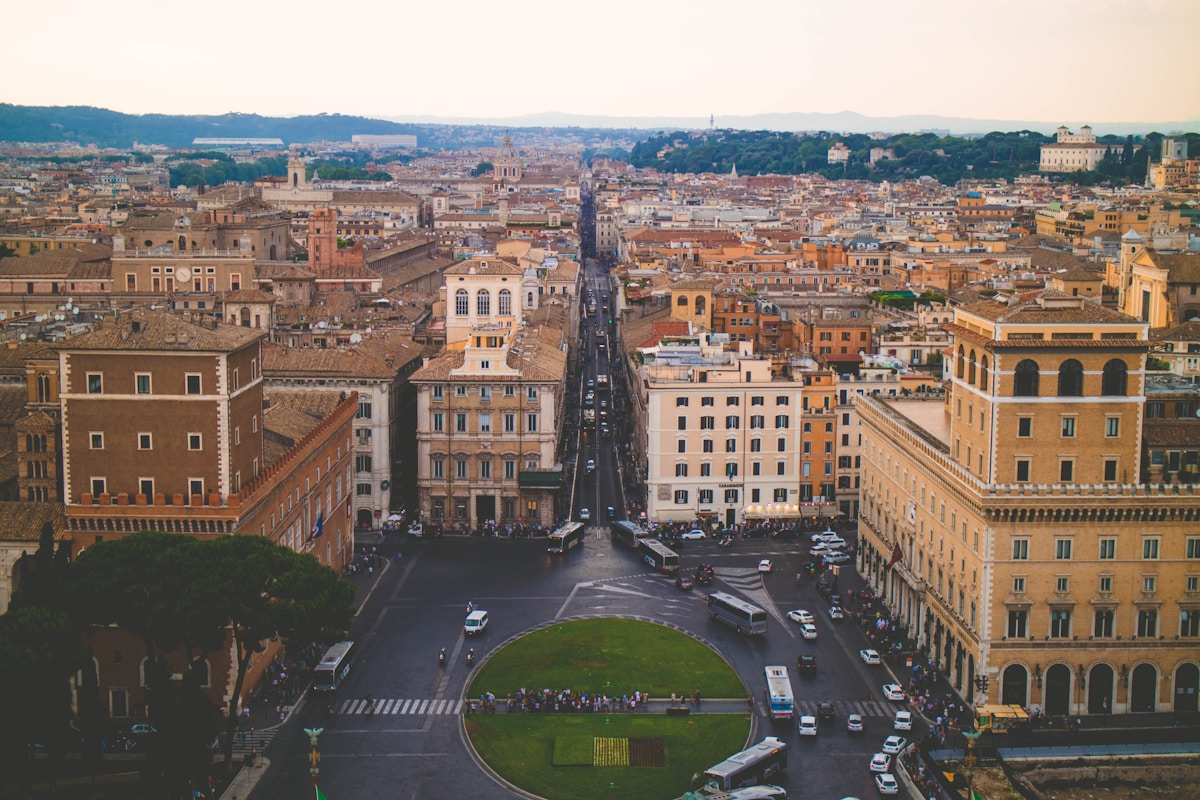
Via del Corso, Rome’s premier shopping street, stretches for over a kilometer through the historic center and offers an extensive mix of international fashion chains and distinctive Italian boutiques.
Shoppers can find everything from affordable souvenirs to high-end Italian-made leather goods, with popular stores like Zara and H&M sharing the thoroughfare with local artisanal shops.
The street’s architectural charm, with its historic buildings and elegant storefronts, creates an atmospheric backdrop for both serious shopping expeditions and casual window browsing.
Exploring Popular Fashion Stores and Local Boutiques
When fashion enthusiasts explore Rome’s shopping scene, they inevitably gravitate toward Via del Corso, the city’s premier retail thoroughfare stretching 1.5 kilometers through the historic center.
This fashion-forward district features an eclectic mix of international brands and Italian craftsmanship.
- Zara and H&M occupy historic palazzos
- Local artisan boutiques showcase handmade leather goods
- High-end Italian fashion houses like Intimissimi and Calzedonia
- Traditional Roman jewelers offering unique pieces
Finding Affordable Souvenirs and Italian-Made Goods
Beyond the glamorous fashion boutiques, Rome’s Via del Corso offers budget-conscious travelers an abundance of affordable souvenir options and authentic Italian-made goods.
Visitors can discover artisanal leather accessories, handcrafted ceramics, locally-produced olive oils, and traditional confections.
The side streets reveal family-owned shops specializing in affordable Italian crafts, while street vendors showcase unique Roman trinkets and memorabilia.
Evening and Nightlife Activities in Rome
As the sun sets over the Eternal City, Rome transforms into an enchanting nighttime destination where ancient monuments glow under artistic illumination and streets buzz with evening social life.
Visitors can experience Rome’s distinct nocturnal character through guided moonlight tours of iconic sites like the Colosseum or by joining locals for the traditional passeggiata, an evening social stroll through historic neighborhoods.
The nightlife in Rome flourishes in areas like Trastevere and Testaccio, where wine bars, craft cocktail lounges, and live music venues showcase Rome’s contemporary cultural scene.
Exploring Rome at Night: A Must-Do in Rome for a Different Perspective
Rome’s iconic landmarks transform into ethereal spectacles after sunset, with strategic lighting that accentuates their architectural magnificence and historical gravitas.
The Colosseum glows amber against the night sky, while the Trevi Fountain’s illuminated waters create a magical atmosphere that differs markedly from its daytime ambiance.
Evening strolls along the Tiber River offer romantic vistas of the city’s bridges and monuments, with their reflections shimmering on the water’s surface and the sounds of the eternal city softening into a gentle nocturnal rhythm.
Seeing Landmarks Like the Colosseum and Trevi Fountain Lit Up
When darkness falls over the Eternal City, its ancient monuments transform into ethereal masterpieces under strategic illumination.
The nighttime lighting creates dramatic shadows and highlights that reveal new architectural details invisible during daylight hours.
- The Colosseum glows amber against the dark sky, its arches casting mysterious shadows
- Trevi Fountain’s cascading waters sparkle with underwater lights
- St. Peter’s Basilica’s dome radiates a golden aura
- The Roman Forum’s ruins take on a mystical quality under moonlight
Walking Along the Tiber River for a Scenic Evening Stroll
The Tiber River offers visitors another enchanting perspective of Rome’s nocturnal beauty, complementing the illuminated monuments that dot the cityscape.
As the ancient waterway winds through the heart of Rome, evening strollers can traverse the cobblestone paths along its banks, discovering charming riverside bars, street musicians, and locals gathering at Trastevere’s lively piazzas, all while enjoying cooler temperatures and peaceful reflections on the water.
Experiencing Rome’s Nightlife: Fun Things to Do in Rome After Dark
Rome’s aperitivo tradition transforms the evening hours into a sophisticated social ritual, with locals and visitors gathering in trendy districts like Trastevere and Monti to enjoy pre-dinner drinks paired with complimentary small plates.
The city’s rooftop bars elevate the nightlife experience, offering craft cocktails against the backdrop of illuminated monuments and the twinkling Roman skyline.
These elevated venues, such as Hotel Locarno Bar and Hotel de la Ville’s Cielo Bar, combine mixology expertise with panoramic views of the Eternal City’s architectural treasures.
Enjoying Aperitivo Culture in Trendy Neighborhoods
Savoring aperitivo, Italy’s cherished pre-dinner ritual, reaches its peak in Rome’s trendiest neighborhoods between 6-9 PM.
This sophisticated social tradition transforms casual bars into bustling hubs of conversation and culinary exploration.
- Trastevere’s intimate wine bars serve regional cheeses and cured meats
- Monti district offers craft cocktails with contemporary antipasti
- Pigneto attracts creative crowds with natural wines and artisanal spreads
- Testaccio combines traditional bites with modern mixology
Visiting Rooftop Bars for Drinks with a View
After enjoying street-level aperitivo scenes, visitors can elevate their evening experiences at Rome’s stunning rooftop bars, where cocktails come paired with panoramic views of the Eternal City.
From Hotel Locarno’s art deco terrace overlooking Piazza del Popolo to Hotel de la Ville’s Cielo Bar with its Colosseum vistas, these sophisticated venues offer the perfect blend of Roman glamour and twilight ambiance.
Planning a Trip to Rome: Tips for Getting the Most Out of Your Visit
Planning strategically allows visitors to experience Rome’s iconic attractions while avoiding the notorious crowds and high costs.
Booking entry times during off-peak hours, typically before 9 AM or after 4 PM, provides a more intimate experience at major sites like the Colosseum and Vatican Museums.
Budget-conscious travelers can take advantage of free admission days at state museums, explore numerous public squares and fountains, and visit remarkable churches without entrance fees.
How to See the Best Attractions in Rome Without the Crowds
Early morning visits to Rome’s major attractions afford travelers peaceful exploration before the masses arrive, with sites like the Colosseum and Vatican Museums being particularly serene during the first entry time slots.
Professional guided tours provide enriching historical context and cultural insights that casual visitors might otherwise miss while traversing Rome’s ancient landmarks.
These expert-led experiences often include priority access to popular sites, combining efficiency with educational value as guides share compelling narratives about the Eternal City’s 2,000-year evolution.
Visiting Popular Rome Tourist Attractions Early in the Morning
One of the most effective strategies for experiencing Rome’s iconic attractions without battling massive crowds is to arrive just as they open their gates for the day.
Early morning visits offer unique advantages:
- The Colosseum glows in golden sunlight before 8:30 AM
- St. Peter’s Basilica welcomes pilgrims starting at 7:00 AM
- The Vatican Museums are peaceful before 9:00 AM
- The Pantheon’s morning light creates ethereal atmosphere from 8:30 AM
Using Guided Tours in Rome Italy to Learn More About the City’s History
Taking a guided tour through Rome’s ancient streets and archaeological wonders provides travelers with deep historical insights that self-guided exploration often misses.
Expert guides reveal hidden stories behind iconic landmarks, decode ancient inscriptions, and share cultural context about Rome’s evolution from Republic to Empire.
Local guides also offer access to less-visited sites and exclusive archaeological areas typically closed to the public.
Budget-Friendly Activities in Rome Italy for Travelers
Rome’s wealth of free attractions and budget-friendly activities makes it possible to experience the Eternal City without breaking the bank.
Visitors can explore iconic sites like the Pantheon, Trevi Fountain, and Spanish Steps at no cost, while many churches showcase masterpieces by Renaissance artists without admission fees.
Budget-conscious travelers can also savor authentic Roman cuisine at neighborhood trattorias, browse local markets like Campo de’ Fiori, and enjoy free cultural events in public piazzas throughout the year.
Free Things to Do in Rome That Are Worth the Visit
Despite being one of Europe’s most visited capitals, Rome offers numerous enchanting attractions that won’t cost travelers a single euro.
Visitors can immerse themselves in the city’s rich history and culture through these free experiences:
- Wandering through the majestic Pantheon’s columned entrance
- Tossing coins in the baroque Trevi Fountain
- Climbing the Spanish Steps at sunset
- Exploring Villa Borghese’s lush public gardens and art-filled walkways
Affordable Ways to Enjoy Rome’s Food, Shopping, and Entertainment
While Rome’s grand monuments and museums often steal the spotlight, savvy travelers can experience the city’s lively culture through numerous budget-friendly dining, shopping, and entertainment options.
Visitors can savor authentic pasta dishes at neighborhood trattorias, browse local markets like Campo de’ Fiori, catch free concerts in piazzas, and explore vintage shops in Monti for unique Italian fashion finds.
Wrapping Up: Finding the Best Things to Do in Rome
While many tourists hurriedly traverse Rome, checking off grand monuments from their lists, they frequently overlook the true spirit of the city.
Rome’s genuine character is revealed not amidst the bustling crowds at the Colosseum or the packed corridors of the Vatican, but rather within quiet morning cafés, secluded piazzas, and casual interactions with residents.
The city’s greatest paradox is that authentic moments emerge precisely when visitors cease their attempts to witness everything.
Frequently Asked Questions (FAQs)
What's not to miss in Rome?
Rome is a city bursting with history, art, and culture, offering endless experiences that you won’t want to miss. Right at its heart stands the Colosseum, a legendary amphitheater that once set the stage for thrilling gladiator battles and grand public spectacles.
Beyond the Colosseum, the Vatican Museums and Sistine Chapel are absolutely worth a visit. The Vatican Museums are filled with an incredible collection of art and historical artifacts gathered over centuries by popes, while the Sistine Chapel is famous for Michelangelo’s stunning frescoes.
Another marvel of ancient architecture, the Pantheon, is one of the best-preserved historic buildings in Rome, with its magnificent dome continuing to impress people to this day.
For a more laid-back experience, Piazza Navona is the perfect place to soak in Rome’s charm. This lively square is home to stunning fountains, including Bernini’s breathtaking Fountain of the Four Rivers, and is lined with beautiful baroque buildings and bustling cafes. And, of course, no trip to Rome would be complete without stopping by the Trevi Fountain.
What are the top 5 things to do in Rome?
Exploring the Colosseum’s underground tunnels is exciting. This tour shows the hidden areas where gladiators got ready for fights. It offers a unique view of Rome’s past and engineering.
Taking a cooking class is also fun. Rome is known for good food. Learning to make Italian food like pasta or pizza is a great way to enjoy the local culture. You can eat what you make with others, making it a fun experience.
If you like art and history, visit the Vatican Museums with a tour. These tours show you the art and history you might miss otherwise. Seeing Michelangelo’s paintings in the Sistine Chapel is the best part. They are amazing.
Walking through Rome’s old neighborhoods is a nice way to see the city. Places like Trastevere and Monti have history, buildings, and street life, with many cafes and shops.
Making gelato is a sweet activity. You’ll learn how to make Italian gelato and taste it. It’s a fun way to learn about Rome’s food. Rome has many things to do, whether you like history, food, or just enjoying the city.

